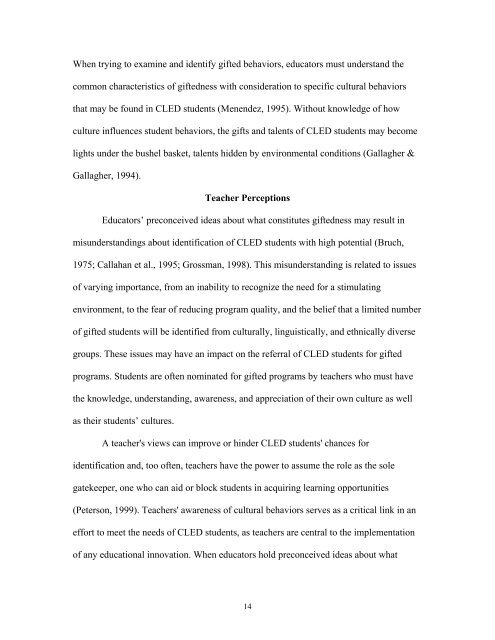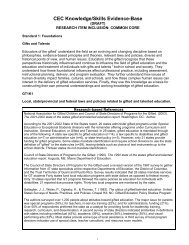Chapter One An Introduction to the Topic of Cultural Diversity - NAGC
Chapter One An Introduction to the Topic of Cultural Diversity - NAGC
Chapter One An Introduction to the Topic of Cultural Diversity - NAGC
You also want an ePaper? Increase the reach of your titles
YUMPU automatically turns print PDFs into web optimized ePapers that Google loves.
When trying <strong>to</strong> examine and identify gifted behaviors, educa<strong>to</strong>rs must understand <strong>the</strong><br />
common characteristics <strong>of</strong> giftedness with consideration <strong>to</strong> specific cultural behaviors<br />
that may be found in CLED students (Menendez, 1995). Without knowledge <strong>of</strong> how<br />
culture influences student behaviors, <strong>the</strong> gifts and talents <strong>of</strong> CLED students may become<br />
lights under <strong>the</strong> bushel basket, talents hidden by environmental conditions (Gallagher &<br />
Gallagher, 1994).<br />
Teacher Perceptions<br />
Educa<strong>to</strong>rs’ preconceived ideas about what constitutes giftedness may result in<br />
misunderstandings about identification <strong>of</strong> CLED students with high potential (Bruch,<br />
1975; Callahan et al., 1995; Grossman, 1998). This misunderstanding is related <strong>to</strong> issues<br />
<strong>of</strong> varying importance, from an inability <strong>to</strong> recognize <strong>the</strong> need for a stimulating<br />
environment, <strong>to</strong> <strong>the</strong> fear <strong>of</strong> reducing program quality, and <strong>the</strong> belief that a limited number<br />
<strong>of</strong> gifted students will be identified from culturally, linguistically, and ethnically diverse<br />
groups. These issues may have an impact on <strong>the</strong> referral <strong>of</strong> CLED students for gifted<br />
programs. Students are <strong>of</strong>ten nominated for gifted programs by teachers who must have<br />
<strong>the</strong> knowledge, understanding, awareness, and appreciation <strong>of</strong> <strong>the</strong>ir own culture as well<br />
as <strong>the</strong>ir students’ cultures.<br />
A teacher's views can improve or hinder CLED students' chances for<br />
identification and, <strong>to</strong>o <strong>of</strong>ten, teachers have <strong>the</strong> power <strong>to</strong> assume <strong>the</strong> role as <strong>the</strong> sole<br />
gatekeeper, one who can aid or block students in acquiring learning opportunities<br />
(Peterson, 1999). Teachers' awareness <strong>of</strong> cultural behaviors serves as a critical link in an<br />
effort <strong>to</strong> meet <strong>the</strong> needs <strong>of</strong> CLED students, as teachers are central <strong>to</strong> <strong>the</strong> implementation<br />
<strong>of</strong> any educational innovation. When educa<strong>to</strong>rs hold preconceived ideas about what<br />
14

















